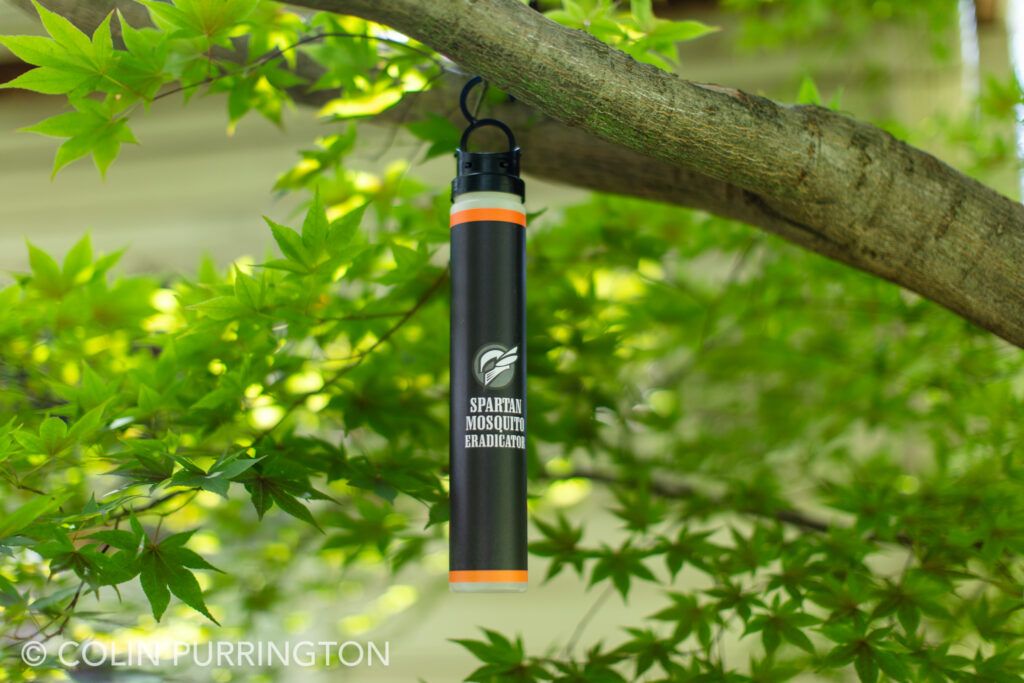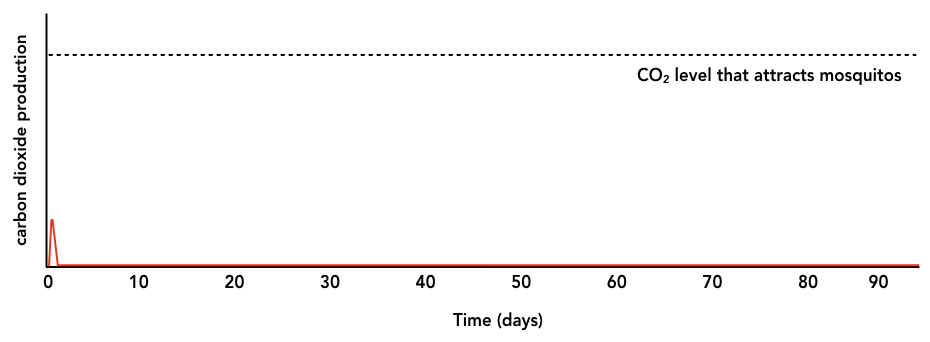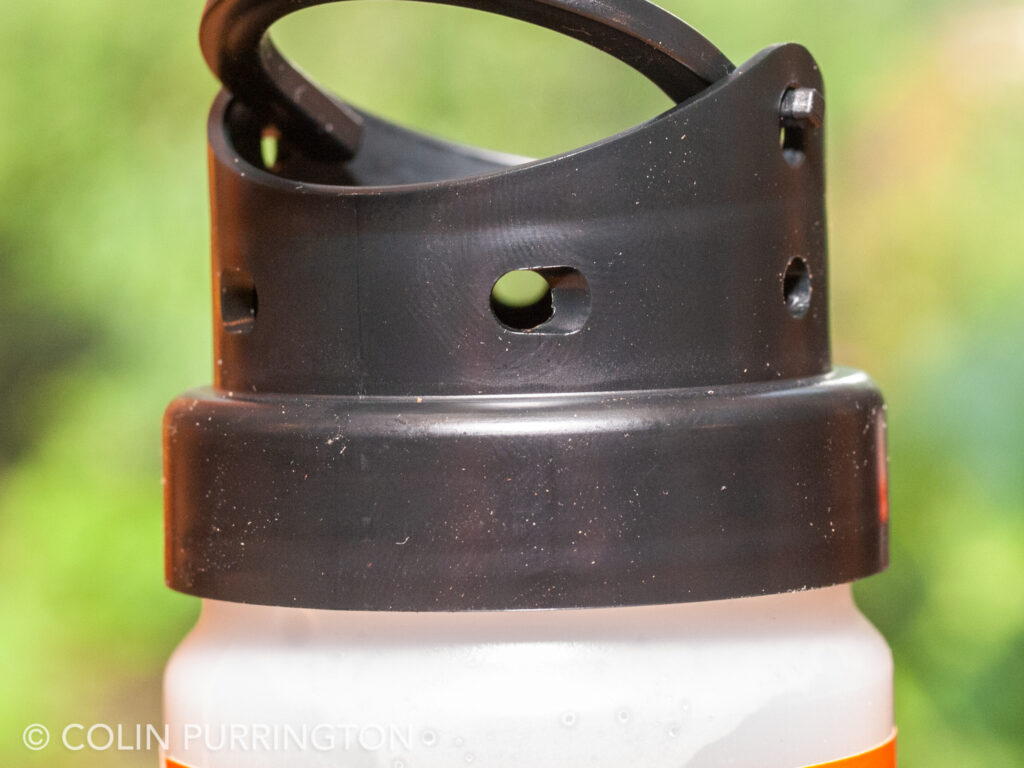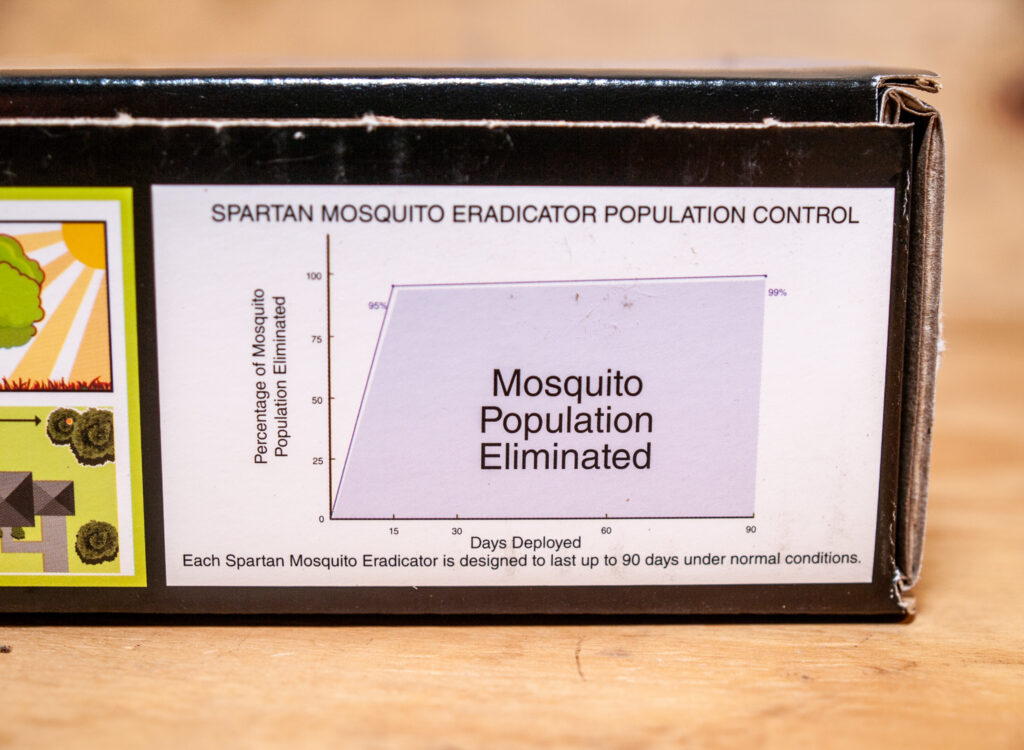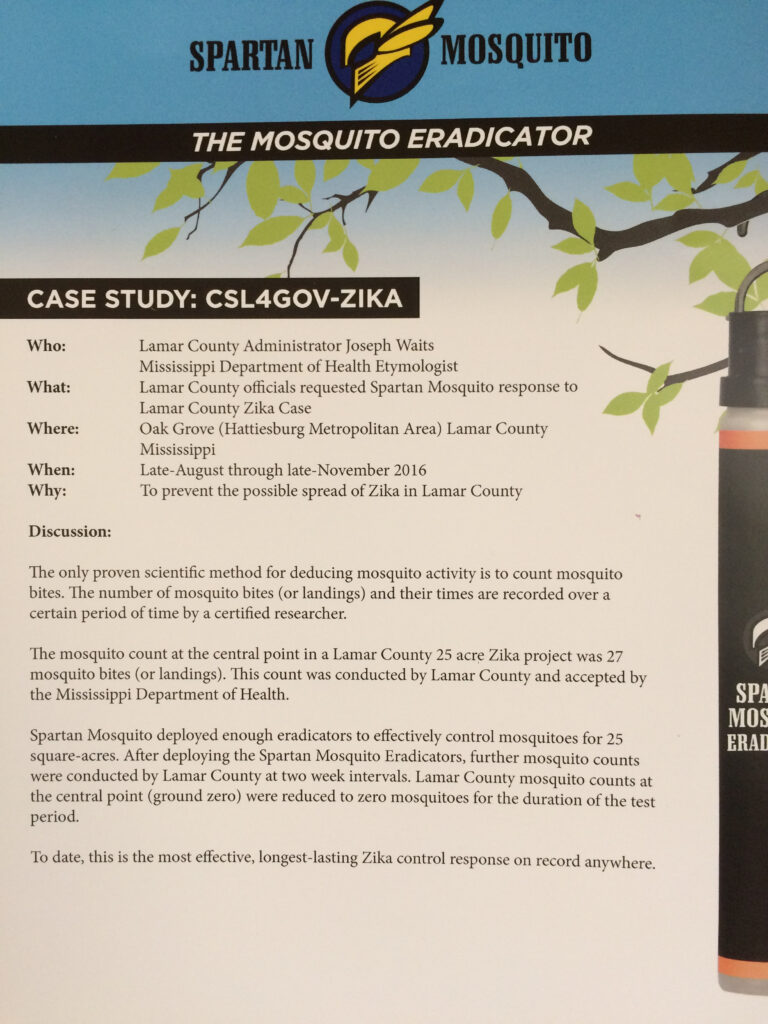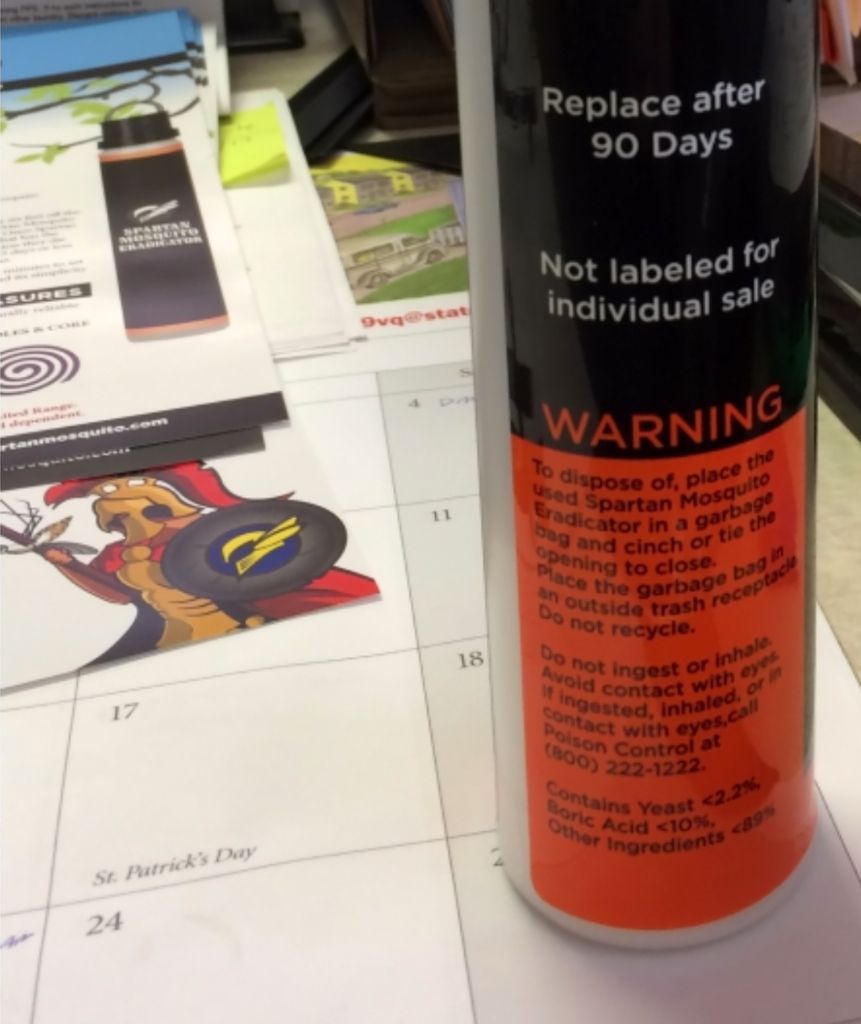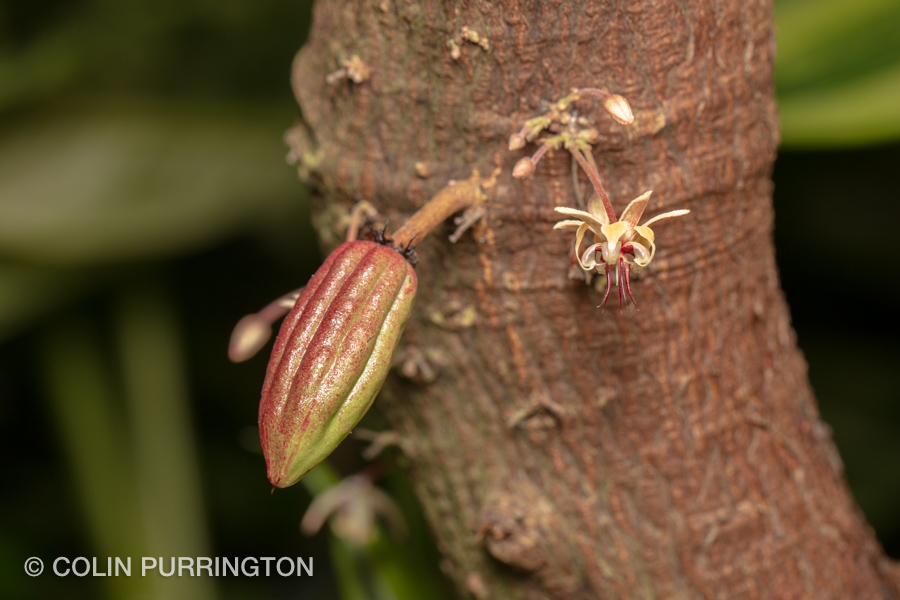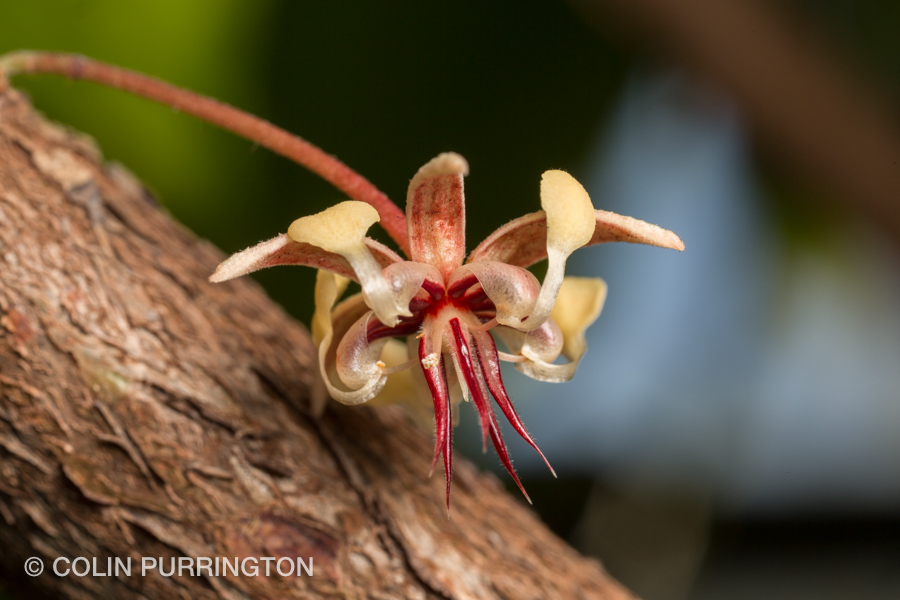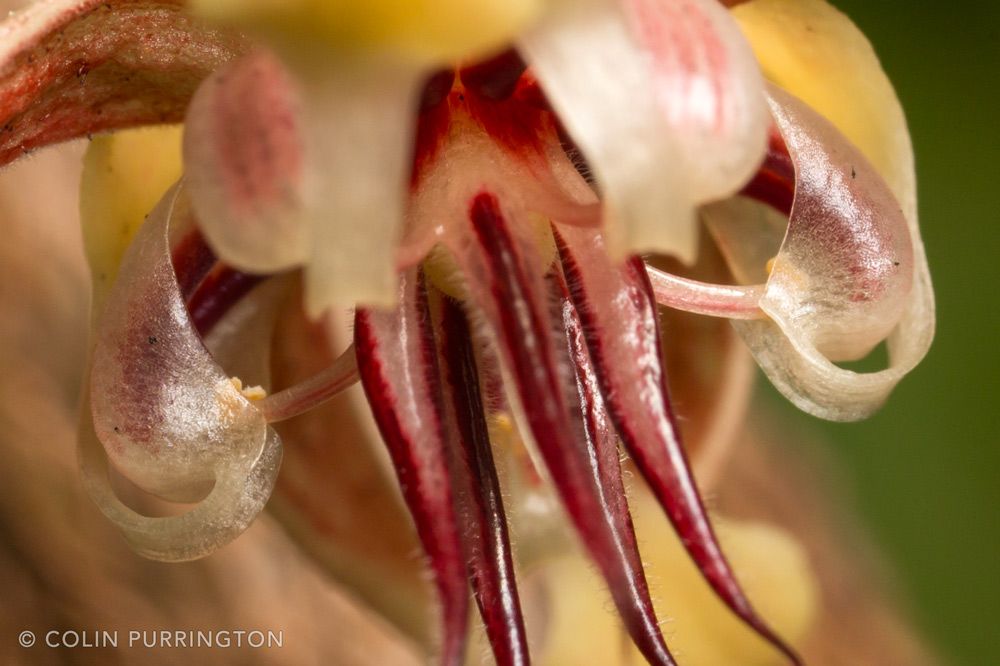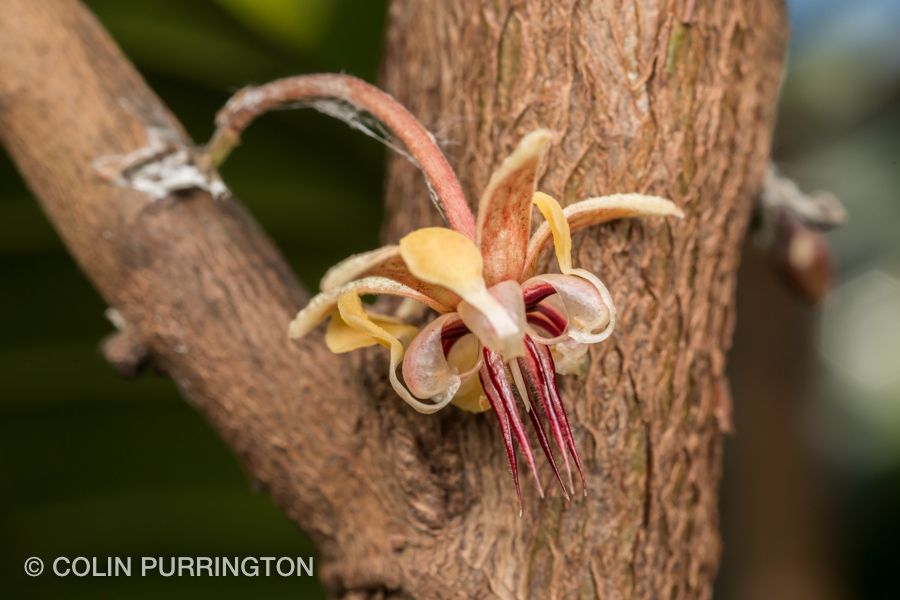Spartan Mosquito Eradicators are selling like hotcakes around the country so I bought two and thought I’d share some thoughts. The devices are plastic tubes filled with water, sucrose, salt, and yeast that you hang in your yard. Per the company, mosquitoes are lured to the devices by the CO2, volatiles, and heat produced by the yeast, crawl inside (through holes in the cap), drink the liquid, crawl back out, then eventually die when their guts rupture (because of the salt and CO2). Company claims that up to 95% of a yard’s mosquitoes are killed for up to 90 days. The box also says that the mosquito population will “suffer dramatically” in the first 15 days.
Below is an infomercial on the Spartan Mosquito Eradicator featuring Jeremy Hirsch, one of the inventors. Ten more videos are available on YouTube.
Did they work?
No. I failed to notice any drop in the numbers of mosquitoes in my yard. I also went near the devices regularly to see whether I would see the promised cloud of mosquitoes that are supposed to be attracted, but I never noticed a single mosquito on or even near them. I checked the devices several hundred times during the summer.
My Spartan Mosquito Eradicators did kill a lot of insects, though (see pics). In fact, after several weeks the liquid inside became a bubbling, stinking, charnel pit. I even found fly larvae writhing around inside (video below) — the devices were apparently producing flies for my yard. When I poured the goo out and sorted through all the carcasses there wasn’t a single mosquito in the mix.
Why didn’t they work?
In my opinion, there are four reasons why the Spartan Mosquito Eradicator is unlikely to kill a single mosquito unless it falls from the tree and lands on one.
First, the device clearly doesn’t attract mosquitoes. One likely reason is that they don’t produce sufficient amounts of CO2 to mimic what a bird or mammal produces. It turns out that you’d need a lot more sugar to achieve that level of CO2 production (Saitoh et al. 2004, Smallegange et al. 2010, Obenauer et al. 2013, and Jerry et al. 2017). And even if the Spartan Mosquito Eradicator had a 1-gallon reservoir (instead of a ~1 1/2 cups), the fermentation process would likely be complete after 48 hours or so, leaving the device useless for the remaining 88 days (its advertised life is 90 days). Here’s a visual mock-up how there might be a small amount of CO2 after you first add water, but then no CO2 production for the bulk of the remaining 90 days:
Indeed, the company admitted to pesticide regulators in Indiana that the Spartan Mosquito Eradicator does not produce enough CO2 to attract mosquitoes (see page 4 of this PDF).
Another reason it’s probably unattractive to mosquitoes is that the tube smells like rotting insects after a week, not a nice piece of fruit or flower crammed with nectar. Mosquitoes are not attracted to rotting insects.
It’s noteworthy that Spartan Mosquito’s website doesn’t show a single photograph of a mosquito arriving at (or resting on) one of its devices when set up in a yard. And, similarly, the company doesn’t have a single video of a deployed Spartan Mosquito Eradicator with a swarm of mosquitoes trying to get in. The lack of photographs and video is an indicator, to me, that the owners know fully well the device does not attract mosquitoes.
Second, the fermentation reactions inside the tube are not likely to generate enough heat to make the device a thermal target for mosquitoes. Again, even if there was a slight temperature spike on the first day (when there is plenty of sugar), that increase will not last for three months. And, again, nowhere on the company’s website is there any documentation of a temperature increase. Again, I’d bet good money that the company knows that the tubes are not heating up from the fermentation.
Third, there’s nothing inside the device that would kill a mosquito even if it went inside and drank the fluid. Here’s what the company says happens:
“When a mosquito ingests the Sodium Chloride (salt), its crystalline structure ‘cuts’ their stomach, causing it to rupture. The fermentation process also continues after mosquitoes ingest the mixture, and CO2 production in the mosquito also causes the stomach to rupture.”
There is no scientific literature that supports either of these things happening. Salt, for example, is not in a crystalline form when dissolved, so there are no sharp crystals at all. It’s idiotic to assert otherwise. And it is well-established by science that salt solutions are not fatal to adult mosquitoes (Yee et al. 2020). Indeed, the ability of mosquitoes to easily deal with saline solutions is demonstrated every time they drink our blood.
It’s also worth noting that mosquitoes have been drinking fermenting liquids (nectar and rotting fruit) for tens of millions of years without exploding from the carbon dioxide produced by yeasts. Mosquitoes always have yeast in their guts. The owners just made up the “mosquitoes can’t vent CO2” phrase because it sounded dramatic. I’d again guess that the owners know full well that this isn’t true.
Fourth, the holes in the cap are likely too small (5/32″, 4 mm) to allow mosquitoes to enter, at least with regard to mosquitoes in search of rotting fruit. There’s not a huge literature on what size holes mosquitoes can crawl through, but Dickerson et al. (2018) found that only 1 out of 100 female Aedes aegypti mosquitoes went through an 8-mm hole after 1 hour when presented with a host. Although a hungry female mosquito might squeeze itself through a small hole in search of a warm mammal (Bidlingmayer 1959), I doubt that they would do the same merely for some rotting sugar water. And I think it’s even more improbable that clouds of mosquitoes would find this hole acceptable even if there were mice stuffed inside the tube.
I think a fundamental problem of the Spartan Mosquito Eradicator is that in a typical yard mosquitoes have plenty of nectar and fruit sources already. So even if a mosquito could be coerced to enter a small hole under laboratory conditions of starvation, it is simply not going to do that in the real world. For an experiment that underscores this issue, please see Beier et al. 2012.
The owners view the critique above as slanderous and like to show videos of mosquitoes going through the holes. But the conditions the company uses are artificial: they put the devices inside small aquaria with several hundred, starving mosquitoes. And, apparently, only several mosquitoes ever stumble through the holes. There’s zero evidence those mosquitoes ingested anything while inside.
The ultimate test, of course, is to put these tubes outside under natural conditions and measure the number of mosquitoes after a set number of days, and then compare those numbers with controls. That’s now been done (Aryaprema et al. 2020), and the authors conclude that Spartan Mosquito Eradicators do not work.
In summary, peer-reviewed scientific research has showed that salt does not kill mosquitoes and that Spartan Mosquito Eradicators do not work.
What should be done?
All of the above are good reasons why nobody should waste their money on Spartan Mosquito Eradicators. But I can’t simply end my review there. This device puts people at risk of contracting mosquito-borne diseases. I.e., because many people apparently think they are protected from mosquitoes if they have Spartan Mosquito Eradicators set up in their trees, they might fail to use CDC-recommended repellents. And some percentage of these people will contract one of the many diseases that are present in the United States.
So the remainder of this post highlights where I think the company has violated FTC and EPA rules. If the sections seem overly long, that’s because I wanted to convey the very real sense that the company has been getting away with a lot, and for many years. These persistent and egregious violations warrant, I think, fines as well as immediate stop-sell orders.
Lack of trustworthy efficacy data
I’m fairly sure that Spartan Mosquito has misled governmental regulators about the effectiveness of the device for years. For example, here’s the graph on the box (and on website, Facebook) that claims to show mosquito populations are all but eliminated for 90 days.
A typical person is going to see this graph and assume that an actual experiment was done and that the device can virtually eliminate mosquitoes for 90 days. However, no details about this graph are ever given on the website — there’s no way to assess whether it was a well-planned experiment or, indeed, whether it even happened. The only information I gleaned was from the URL of the same graph on the company’s website,
https://spartanmosquito.com/wp-content/uploads/2017/03/Diagram-of-What_V3.jpg
which shows that the image was uploaded to the website in March of 2017. That must mean the experiment was done in 2016 or before. I’ve talked to a lot of people about this graph and I think it shows the number of mosquitoes landing on the company owner’s arm on two different days during an event in Fall 2016 that the company calls, “Case Study CSL4GOV-ZIKA”, described below in a handout the company distributed to some Mississippi towns (they were trying to drum up government contracts):
The document says that a Lamar County official (Joseph Waits) and an etymologist [sic] from the Mississippi Department of Health conducted a study in late 2016 (as described in this story). The wording implies that the Spartan Mosquito Eradicators deployed in the area eliminated 100% of mosquitoes and that the Mississippi State Department of Health participated and approved of the data. It turns out the real reason the final mosquito count was zero was because the State of Mississippi sprayed the neighborhood with insecticides (on multiple days). By advertising with this graph, Spartan Mosquito has been misleading the public.
Another reason I think the graph refers to this event is because Mr Hirsch talked told a reporter that his “Zika-control event” lasted 90 days (png). Here’s the video in which he says that:
Even if the above data (and graph) were for some reason acceptable, there’s another way the company has been deceptive. In Fall 2016 the company was using boric acid as the active ingredient, not salt. Here’s a photograph of the device taken in March 2017 that shows boric acid as the active ingredient (you can also see the “boric acid” on the label if you do a screen grab on the video above).
It appears, then, that the efficacy data that Spartan Mosquito has been supplying to states and presenting to the public are based on a completely different device, not one that used sodium chloride as the active ingredient.
False or misleading efficacy claims
Spartan Mosquito Eradicators don’t contain a regulated pesticide so they are sold under a FIFRA 25(b) exemption. This means, in most states, that the device can be sold without providing any efficacy data. But they can only claim to be a 25(b) if they make zero false or misleading claims. Plus they may not make any claims about efficacy or disparage the efficacy of other products. Below is a small sampling of such claims. In each instance I’ve added an image file that highlights the quoted text.
- According to Mr Hirsch, he chose the name, Spartan Mosquito Eradicator, to convey the “exterminate” sense of the word: “to get rid of completely usually by killing off” (source). Per the EPA, “product names cannot constitute false and misleading claims”.
- The graph is an efficacy claim. (jpg)
- “Eradicate your mosquito population for up to 90 days”. (jpg)
- “The mosquito population … will be 95% controlled for up to 90 days”. (box; Facebook)
- “The Eradicator lasts up to 90 days and is proven to dispel up to 95 percent of your mosquito population in approximately 15 days.” (jpg)
- “With proper placement, the Mosquito population in the area will diminish by 95% in 15 days or less.” (jpg)
- “Spartan Mosquito Eradicators are extremely effective in controlling and decimating mosquito populations.” (jpg)
- “In every case, mosquito “hits” (mosquito bites or landings) are reduced to near zero, or zero, within weeks or even days.” (jpg)
- “… better than sprays, repellents, candles, and repellent services …” (jpg)
- “The Spartan Mosquito Eradicator is the most effective, longest lasting, continuous mosquito control system.” (jpg) Exaggerated claims because device has not been tested against every other device on planet.
- Spartan Mosquito asserts that spray services (pyrethroids), bug zappers, repellents (e.g., DEET), etc., are all “less effective”. (jpg)
- “All of our 3rd party efficacy studies submitted and accepted by regulatory authorities in the United States demonstrate our devices destroy at least up to 95% of given populations.” (jpg)
False, illegal health claims
Devices with FIFRA 25(b) exemptions may not make any health claims, either. But company does so frequently. Here is a sampling.
- “To date, this is the most effective, longest-lasting Zika control response on record anywhere.” (jpg; jpg)
- “Purchase the Spartan Mosquito Bomb and fight the Zika virus!” (jpg)
- Its primary distributor implies that the device can protect families from eastern equine encephalitis. (jpg
- A reseller claims that the device can protect against mosquito-borne disease (YouTube).
- The company says its device is “chemical free“, a claim prohibited by the EPA. (jpg) It’s also untrue (e.g., NaCl, H2O, C12H22O11).
- “Spartan Mosquito is an all-natural alternative …” (jpg)
- “…all-natural ingredients…”. (jpg)
- The company implies repellents are harmful. (video 1, video 2, video 3).
- The company includes a photograph of a pregnant woman on the box to imply the device is safe. (jpg)
- The website mentions encephalitis, yellow fever, dengue fever, malaria on numerous occasions. Owner also mentions diseases when interviewed. This has the effect of implying the device can protect against such diseases. (Google search)
- “Fewer bites equal fewer opportunities for mosquito-borne illnesses.” (jpg)
- Television ad that says device is proven to protect against diseases. (Facebook video)
- Spartan Mosquito invokes health concern about diseases on first page of brochure by writing, “the mosquito is the deadliest animal in the world”, “U.S. Center for Disease Control”, and “World Health Organization”. (jpg)
- Spartan Mosquito includes paragraph about the World Health Organization on website to imply it is a peer association and collaborator. The name-dropping also serves to increase search-related keyword matches. (jpg)
Misleading statements about active ingredient
The company has listed “sodium chloride” on the box as the sole active ingredient yet does not present data that shows sodium chloride kills adult mosquitoes. Here’s the relevant requirement from the EPA:
“Active ingredients are the ingredients that kill, repel, or mitigate the pests identified on the product label. If an ingredient does not perform one of these functions, then it is an inert ingredient and should not be identified as an active ingredient on the label.”
https://www.epa.gov/minimum-risk-pesticides/conditions-minimum-risk-pesticides
So saying that sodium chloride is the active ingredient violates EPA rules. It appears the owners know the salt doesn’t kill mosquitoes, too, because on multiple webpages, on replies to Amazon reviews, and in videos, owners have suggested that it is the carbon dioxide, instead, that causes mosquitoes to die. This “mosquitoes have no way to expel gas” assertion is featured (png), for example, in the brochure that Spartan Mosquito gives to potential distributors and resellers. This switch in mechanism of action appears to suggest that the company has misled regulators about the active ingredient. And, also, that the company misled the states about the inactive ingredients.
False or misleading statements
Here are some assertions that Spartan Mosquito makes that appear to be false or misleading.
- Company asserts that mosquitoes are drawn to the device by carbon dioxide. Company does not have data to support this claim. It is my understanding that the company has data showing the device does not produce sufficient CO2 to be attractive. It has not released these negative data. (jpg)
- Company asserts that salt and CO2 cause mosquito death: “When a mosquito ingests the mixture in Spartan Mosquito Eradicators, the Sodium Chloride combined with the CO2 produced by the fermentation process causes the mosquito’s stomach to rupture.” As discussed above, there is no evidence that either salt or CO2 kills mosquitoes.
- “Spartan Mosquito Eradicators are designed to maintain a specific salinity balance…” (jpg). There is no evidence that this device can maintain a particular salt level.
- Company claims the devices “form a barrier around the property.” (png; pdf) Device does not fit the definition of a barrier.
- “… a unique solution activated by simply adding warm water, shaking, and hanging…” (jpg). Also from website, Amazon: “…uniquely effective …” (jpg). EPA rules specifically prohibit the use of the word, “unique”.
- Company insists that mosquitoes don’t die inside the device but rather later, after leaving the device. Company makes this assertion, I think, to undermine the obvious criticism that mosquitoes are never found inside the device.
Deceptive marketing practices
Spartan Mosquito fails to disclose relevant information to consumers about testimonials, videos, and newspaper articles that promote its device. Some examples are below.
- The testimonial by “Michael B.” (jpg) on the website may have been authored by Michael Bonner, father of one of the co-owners (Chris Michael Bonner) of Spartan Mosquito. Micheal Bonner is a resident of Hattiesburg, where the company is based and where both owners live. Michael Bonner is also owner of Bonner Analytical Testing Laboratory, where his son Chris is employed. Some of the “tests” of the Eradicator take place on Micheal Bonner’s property. He has a PhD (jpg). NB: most other reviewers have last names fully spelled out, so the use of “B” is to obscure who this person is (deception).
- At least two testimonials appear to apply to the boric-acid version, not the salt-based one that is currently available. E.g., the review by Michael B. (jpg) was dated 2015, and the review by Joe K. (jpg; likely Joe Kintzel of Hattiesburg, deceased April 2016) must also refer to results from before his death (i.e., sometime during 2015). Given his age at death, I suspect he was a friend or acquaintance of Michael Bonner (the father of Chris Bonner, co-owner of company). All of the undated testimonials on the website are thus suspect — all could refer to the devices that shipped with boric acid.
- Two testimonials (“Jesse L.” and “Mark G.”; jpg) featured on website appear to be people involved in early testing by the company. Jesse L. is part of this test, and website/Facebook mentions testing done on the Mississippi Delta (jpg). It’s likely these guys received free devices.
- Company makes extensive use of television-like videos on website, Facebook, and YouTube without disclosing that segments are paid promotional ads, not real interviews. E.g., all the videos from First Coast Living, such as this one.
- Similarly, many of the items in the “News” section of its website appear to be publications that were paid for by Spartan Mosquito.
- Company uses a photograph (jpg) of a government official (wearing a Spartan Mosquito t-shirt) in a government room to imply that the device has official, governmental approval. The person pictured is Dr Phillip Stoddard, the mayor of South Miami and a professor of biology at Florida International University. I strongly suspect he does not endorse this device or even know he is being used in advertising.
Unethical customer support
When customers on Amazon give the device low ratings, the company will never admit that the product doesn’t work. Instead, it blames the users, insisting they failed to (1) deploy the devices early enough, (2) buy enough units for the size of the property, (3) place them in right spots, (4) place them at the right height in trees, or (5) wait long enough for devices to start working their magic. In many cases, the company asserts that customer is guilty of all of the above. I fully understand that some types of devices (e.g., airplanes) don’t work if instructions are not followed exactly, but I’d argue that the Spartan Mosquito Eradicators is not such a device. The insistence that “directions weren’t followed” seems more like a scheme to immunize the company against scam complaints.
If a buyer persists in claiming the devices simply don’t work, the company will ask the customer to call a “Deployment Specialist”, somebody who will call up your street address on a Google satellite map and tell you where you should put the devices. That’s creepy.
What can be done?
I’ve done all of the below but pesticide regulators are much more likely to act if they hear from additional citizens. Please choose one of the below if you have a minute:
- Email your state regulator.
- File a complaint with the Federal Trade Commission.
- Report misleading advertising to your State Attorney General.
If you are contacting your state regulatory office, it’s best if you mention a specific reason why you think they should initiate a review of the Spartan Mosquito Eradicator. The most straightforward reason is that the Mosquito Eradicator simply does not satisfy Condition 6 (“The label cannot include any false or misleading statements”) of the FIFRA rules governing pesticides in the Minimum Risk category. I.e., because of it makes misleading, untrue statements on the box, the Spartan Mosquito Eradicator cannot claim to be exempt from EPA oversight. That language might seem awkward but all state regulatory personnel will know exactly what you are talking about. Indeed, I guarantee that every single state regulatory official already knows that Spartan Mosquito Eradicators violate Condition 6 … it’s just a question of encouraging them to act on that information. Here‘s the part of the EPA website that gives more details about Condition 6:
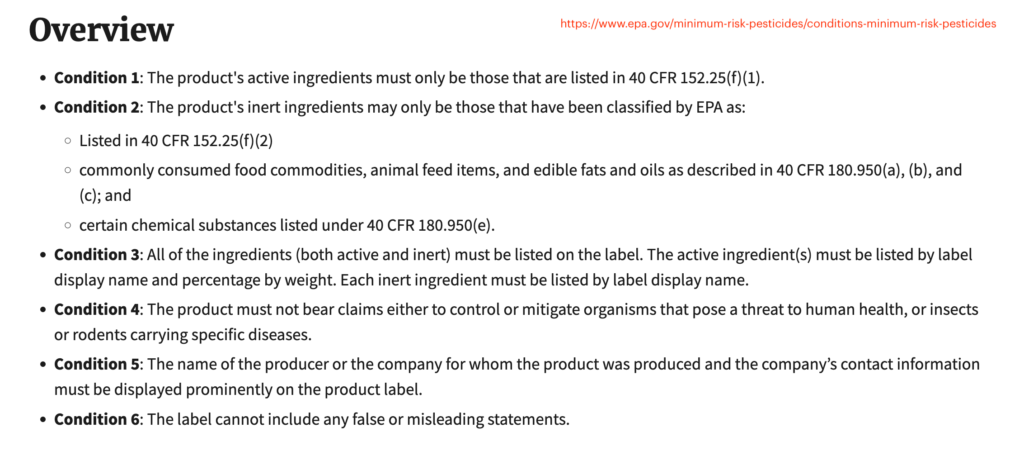
Perhaps the clearest misleading statement on the label is the claim that the Spartan Mosquito Eradicator kills mosquitoes (it does not). Tell the regulatory agency that there is clear scientific research (Yee et al. 2020) in a peer-reviewed journal that demonstrates that salt does not kill adult mosquitoes. And there’s an additional publication (Aryaprema et al. 2020) that specifically tested whether the Spartan Mosquito Eradicator worked to control mosquitoes (it did not). I.e., it’s not just common sense that salt is unlikely to kill adult mosquitoes — scientists have shown that it doesn’t.
Alternatively, inform your state regulator that the label on Spartan Mosquito Eradicators violates Condition 1. I.e., the label asserts that sodium chloride is an active ingredient, but it is not. It is inert (doesn’t kill mosquitoes).
Here is the full list of states that have denied registrations: California, Connecticut, Idaho, Indiana, Kansas, Maine, Maryland, Montana, Nebraska, New Mexico, New York, Nevada, Pennsylvania, Utah, Washington, and D.C.
More information
For further details about the Spartan Mosquito Eradicator and its manufacturer, please see, “Posts about Spartan Mosquito“. There’s a page devoted to the class-action suit against the company (settling out of court for $3 million).
Want to help?
Post a link to this review on Facebook.

